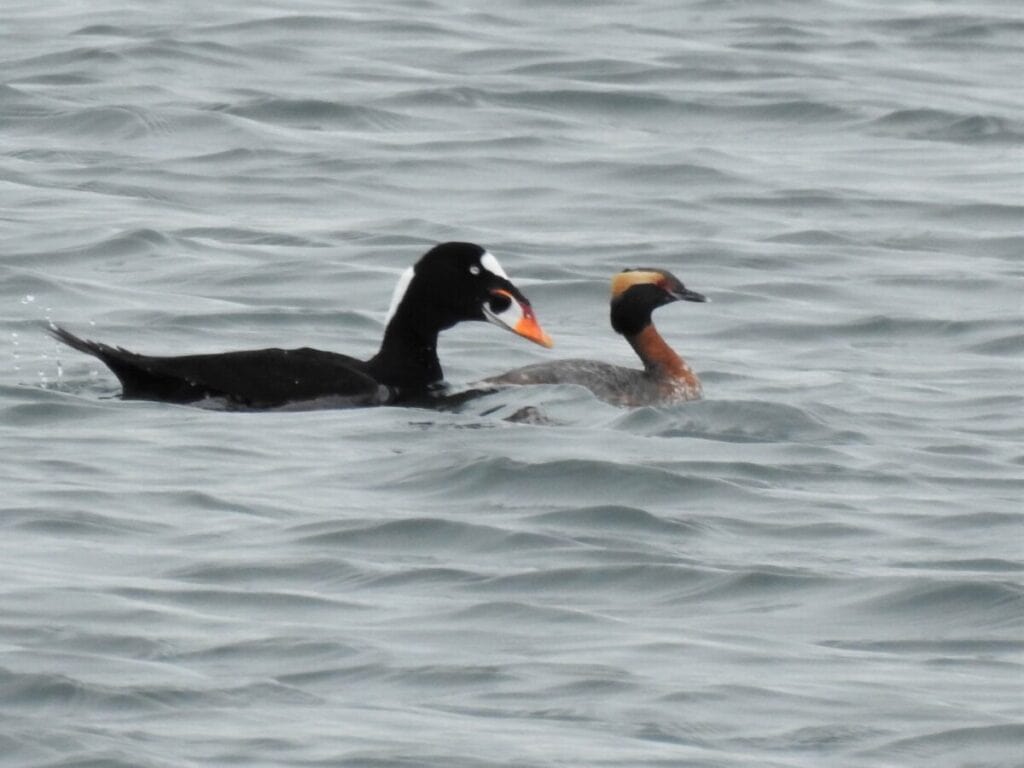Fifteen of us, of various ages and levels of bird knowledge, face into an icy wind on Glacier Spit across the bay from Homer, Alaska. I’m bundled in three layers of clothing below the waist, four above. Add stocking hat, neck gator, winter mittens with chemical hand warmers tucked inside.
It’s been a cold spring. Snow is still too soft and deep to hike our original route from beach through forest, to Grewingk Glacier, then over a rocky saddle, to drop down at a different beach. Instead we explore this five-mile stretch of beach that gives us several habitats in one location—shoreline, near-shore, off-shore, beach berm, and forest. Many eyes scan our surroundings for seabirds, shorebirds, raptors, and songbirds.
We’ve come to Homer for the Kachemak Bay Shorebird Festival, an annual gathering of humans in early May to witness and celebrate the return of shorebirds, ducks, and sea birds to the waters and mudflats of this rich environment of mountains, shore, and sea. Many birds stop here for no more than a day or two to fuel up on tiny worms and crustaceans they snatch from the thick glacial muck before heading to nesting grounds further North. If birds have survived such a long and perilous journey, surely we humans can weather any trivial obstacles we encounter in our easy lives.
A woman named Mary, white hair escaping from the edge of her wool hat, is a local pro. She identifies several black dots floating several yards from shore. “Horned grebes,” she declares, with their punkish orange tufts on either side of their heads. They’re hanging out with surf scoters, sea birds with outrageously bulbous orange and yellow bills.
“Look! Terns!” someone yells. Binoculars pivot to the sky. Arctic terns, with their black heads and light gray bodies, expert flyers and fishers, have traveled from Mexico and South America to breed and raise their young near our abundant Alaskan waters. At the water line, semipalmated plovers, shorebirds with white breasts and sharp black necklaces, perfectly camouflaged, peck for creatures between the rocks.
It was a rough winter, as evidenced by debris scattered around us. Plastic bottles, all colors and sizes, Styrofoam insulation, pressure-treated lumber that appears never to have made it to its intended construction site, a cleat attached to someone’s destroyed dock, boat bumpers, net floats, and more. People stoop to gather plastic trash and stick it in their packs and pockets to throw away back at the harbor. We could spend the whole day picking up trash, but we have no way to carry it all. Some claim other treasures—a sea otter skull and backbone for an artist in the group, dried sea stars, bird feathers, a piece of a mallard wing plucked from an eagle’s fishing site, and of course rocks of all shades of white and gray rounded with the constant motion of waves and glaciers.
Far back from the current shore, extreme winter high tides, combined with powerful storms, erased the old boundary between forest and sea. Trees lay toppled, roots jabbing skyward, last year’s grasses hanging limp from their limbs, sod rolled up and exposed. A beach transformed, reshaped, remade. It will heal into a different form. Nature’s resilience.
I turn back into the wind and pull my neck gator over my nose, but it slips back down. Runny nose, watery eyes, cracked lips, I’m in the company of people who don’t care what they look like as long as they can look at birds. This is my tribe. I hope to return with the birds again next year to join them.

